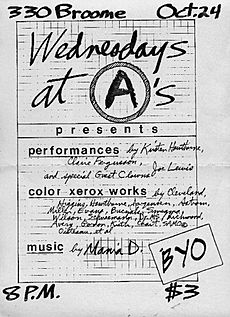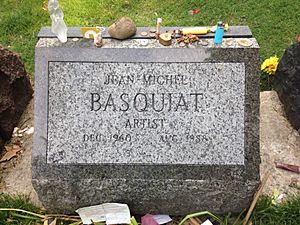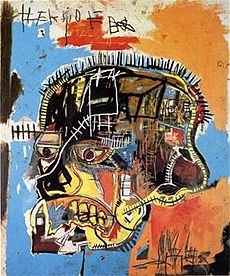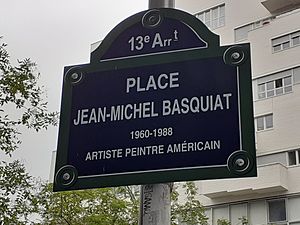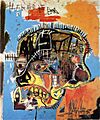Jean-Michel Basquiat facts for kids
Quick facts for kids
Jean-Michel Basquiat
|
|
|---|---|
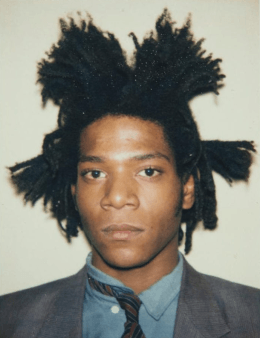
Basquiat by Andy Warhol in 1982
|
|
| Born | December 22, 1960 New York City, U.S.
|
| Died | August 12, 1988 (aged 27) New York City, U.S.
|
| Resting place | Green-Wood Cemetery, Brooklyn, New York City |
| Years active | 1978–1988 |
| Known for | Painting, drawing |
|
Notable work
|
|
| Style | |
| Movement | Neo-expressionism |
Jean-Michel Basquiat (December 22, 1960 – August 12, 1988) was an American artist. He became very famous in the 1980s. His art was part of a style called Neo-expressionism.
Basquiat first became known for his graffiti art. He worked with a friend, Al Diaz, under the name SAMO. They wrote mysterious messages in Lower East Side, Manhattan, in the late 1970s. This area was a hub for early hip-hop, punk, and street art. By the early 1980s, his paintings were shown in galleries and museums worldwide.
At just 21, Basquiat was the youngest artist to be part of documenta in Germany. A year later, he was one of the youngest to show his art at the Whitney Biennial in New York. His art often explored big ideas like rich versus poor, and fitting in versus being separate.
He used poetry, drawing, and painting in his work. He mixed words and pictures, abstract art and realistic figures. He also blended history with comments on modern times. Basquiat used his art to talk about his experiences in the Black community. He also used it to criticize unfair power systems and racism.
Basquiat died at 27 in 1988. Since then, his art has become very valuable. In 2017, one of his paintings, Untitled (1982), sold for over $110 million. It shows a black skull with red and yellow colors. This made it one of the most expensive paintings ever sold.
Contents
Basquiat's Early Life (1960–1977)
Jean-Michel Basquiat was born in Park Slope, Brooklyn, New York City. His birthday was December 22, 1960. He was the second of four children. His father was from Port-au-Prince, Haiti. His mother was born in Brooklyn to Puerto Rican parents.
His mother loved art and took him to museums. She also signed him up as a junior member of the Brooklyn Museum of Art. Basquiat was a very smart child. He could read and write by age four. He loved to draw his favorite cartoons.
In 1967, he started at Saint Ann's School. There, he made a children's book with his friend Marc Prozzo. Basquiat wrote the story when he was seven.
In 1968, a car hit Basquiat when he was seven years old. He broke his arm and had other injuries. While in the hospital, his mother gave him a book called Gray's Anatomy. This book later influenced his art. His parents separated that year. His mother struggled with her mental health. Basquiat and his sisters were raised by their father. By age eleven, Basquiat spoke French, Spanish, and English fluently.
His family moved to Miramar, Puerto Rico in 1974. They returned to Brooklyn in 1976. Basquiat went to Edward R. Murrow High School. He had a hard time with his mother's illness. He ran away from home at 15. His father found him and brought him back.
In 10th grade, he went to City-As-School High School. This was an alternative school in Manhattan for artistic students. He often skipped school but his teachers encouraged him. He started writing and drawing for the school newspaper. He created a character called SAMO for a fake religion.
Street Art and Music (1978–1980)
In May 1978, Basquiat and Al Diaz started spray painting graffiti in Lower Manhattan. They used the name SAMO. They wrote clever and funny messages like "SAMO© AS AN ALTERNATIVE TO GOD." In June 1978, Basquiat was kicked out of City-As-School. At 17, his father told him to leave home when he dropped out of school. He worked at a clothing store and made graffiti at night.
In December 1978, The Village Voice newspaper wrote an article about the SAMO graffiti. In 1979, Basquiat appeared on a TV show called TV Party. He became friends with the host, Glenn O'Brien. He also met students at the School of Visual Arts. These included Kenny Scharf and Keith Haring.
In April 1979, Basquiat helped start a noise rock band called Test Pattern. It was later renamed Gray. They played at famous nightclubs like CBGB. Basquiat lived in the East Village with his friend Alexis Adler. He often copied science diagrams from her textbooks. He also made postcards with his friend Jennifer Stein. He sold one of these postcards to Andy Warhol.
In 1979, Basquiat showed his SAMO art at a space called A's. He also made painted clothes called "MAN MADE" clothing. A designer named Patricia Field sold his clothes and showed his sculptures in her store.
Basquiat and Diaz had a disagreement. Basquiat then wrote "SAMO IS DEAD" on walls in SoHo in 1980. In June 1980, he was featured in High Times magazine. This was his first national publication. Later that year, he started filming an independent film called Downtown 81. His band Gray's music was on the soundtrack.
Becoming Famous (1980–1986)
In June 1980, Basquiat showed his art in The Times Square Show. Art critics noticed him. In February 1981, he was in the New York/New Wave exhibition. An Italian artist, Sandro Chia, told a dealer about Basquiat's work. This led to Basquiat's first solo show in Italy in May 1981. In December 1981, a critic wrote a big article about Basquiat called "The Radiant Child." During this time, Basquiat painted on things he found, like old doors.
Basquiat sold his first painting, Cadillac Moon (1981), for $200. The buyer was Debbie Harry, the singer from Blondie. He also appeared as a DJ in Blondie's music video "Rapture". At this time, his girlfriend, Suzanne Mallouk, supported him financially.
In September 1981, art dealer Annina Nosei invited Basquiat to join her gallery. She gave him art supplies and a studio space. In 1982, he had his first solo show in America at her gallery. He also painted in Italy for a second show. But he felt used and canceled that show.
By summer 1982, Basquiat left Annina Nosei's gallery. Bruno Bischofberger became his main art dealer. In June 1982, at 21, Basquiat was the youngest artist in documenta in Germany. His art was shown with famous artists like Andy Warhol. Bischofberger set up a meeting between Basquiat and Warhol. Warhol said Basquiat painted a picture of them together within two hours. This painting, Dos Cabezas (1982), started their friendship.
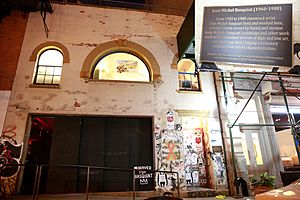
In November 1982, Basquiat had a show at the Fun Gallery. Later that month, he worked in a studio in Venice, California. He was with his girlfriend, who was then an unknown singer named Madonna. The gallery owner said Basquiat told him Madonna would be "huge."
Basquiat was interested in artist Robert Rauschenberg's work. He visited him often. In Los Angeles, Basquiat painted Hollywood Africans (1983). It shows him with graffiti artists Toxic and Rammellzee. He often painted portraits of other graffiti artists. In 1983, he made a hip-hop record called "Beat Bop". He designed the cover art, which made it very popular.
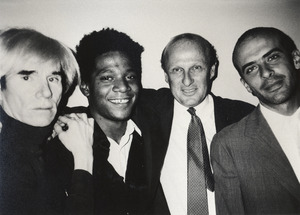
In March 1983, Basquiat was one of the youngest artists in the Whitney Biennial art show. He started a friendship with Warhol. In August 1983, Basquiat moved into a loft owned by Warhol. This also became his art studio.
In summer 1983, Basquiat traveled to Asia and Europe. When he returned, he was sad about the death of Michael Stewart. Stewart was a young Black artist who died in September 1983. Basquiat painted Defacement (1983) because of this event.
Basquiat joined Mary Boone's gallery in 1983. He had his first show there in May 1984. Basquiat and Warhol worked together on many paintings in 1984 and 1985. Warhol would start with a clear image. Then Basquiat would add his lively style. They made art for the 1984 Summer Olympics. Their joint show was called Paintings. Critics did not like it, and their friendship suffered.
Basquiat often painted in expensive Armani suits. He would wear his paint-splattered clothes in public. He was a regular at the Area nightclub. He sometimes DJ'd there for fun. He also painted murals for the Palladium nightclub. His quick rise to fame was in the news. He was on the cover of The New York Times Magazine in 1985. He was also in GQ and Esquire. He even walked the runway for a fashion show.
By the mid-1980s, Basquiat was making a lot of money. But he still felt emotionally unstable. In 1986, he had exhibitions in Los Angeles, Atlanta, and Salzburg. He also traveled to Ivory Coast for a show. In November 1986, at 25, he had an exhibition at Kestner-Gesellschaft in Germany. This made him the youngest artist to have a show there.
Later Years and Passing (1986–1988)
In the last year and a half of his life, Basquiat became more private. In 1987, he had shows in Paris, Tokyo, and New York. He designed a Ferris wheel for an art amusement park in Germany.
In January 1988, Basquiat went to Paris and Düsseldorf for exhibitions. In Paris, he became friends with artist Ouattara Watts. Basquiat died at his home in Manhattan on August 12, 1988. He was 27 years old.
Basquiat is buried at Green-Wood Cemetery in Brooklyn. His funeral was private. A public memorial was held later. Many friends and artists spoke about him. Artist Keith Haring created a painting called A Pile of Crowns for Jean-Michel Basquiat in his memory. Haring wrote that Basquiat created a "lifetime of works in ten years."
Basquiat's Art Style
Basquiat mixed poetry, drawing, and painting in his art. He combined words and images, abstract and realistic styles. He also blended historical facts with comments on current events. His art was very political. He directly criticized colonialism and supported class struggle.
He explored art from many sources. He also questioned traditional art. One art historian said Basquiat was like an "oracle". He took his ideas about the world and showed them through his art. His art often focused on opposites. These included wealth versus poverty, and fitting in versus being separate.
Before he became a painter, Basquiat made punk-style postcards. He also became known for his political graffiti as SAMO. He often drew on everyday objects and surfaces. His paintings are full of different codes. These include words, letters, numbers, and symbols.
Basquiat used many books for ideas. Some were Gray's Anatomy and African Rock Art. From late 1982 to 1985, he made multi-panel paintings. These were dense with writing, collages, and images. He also worked with Andy Warhol during this time.
His Drawings
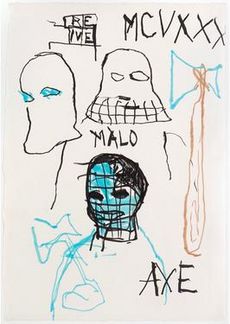
Basquiat made about 1,500 drawings, 600 paintings, and many sculptures. He drew all the time. He used whatever was around him if he didn't have paper. He drew from childhood, inspired by his mother. Drawing was a key part of his art. He used ink, pencil, markers, and oil sticks. He sometimes copied parts of his drawings to use in bigger paintings.
His first public show of paintings and drawings was in 1981. The article "Radiant Child" made him famous in the art world. Basquiat often used words in his drawings and paintings. These words talked about racism, slavery, and New York City life in the 1980s. They also mentioned Black historical figures, musicians, and athletes. Many of his drawings were untitled. So, a word from the drawing is often used to identify it.
Heroes and Saints
Basquiat often showed important Black figures in his art. He saw them as heroes and saints. His early works often used crowns and halos. These symbols showed who the heroes and saints were in his art. A friend said Basquiat's crown had three peaks. These stood for the poet, the musician, and the great boxer.
Art Daily noted that Basquiat's crown changed meaning. Sometimes it was a halo, other times a crown of thorns. This showed the struggles that often come with being a hero. For Basquiat, these heroes were like warriors. They sometimes had their arms raised in victory.
Basquiat loved bebop music. He saw saxophonist Charlie Parker as a hero. He often mentioned Parker and other jazz musicians in his paintings. Examples include Charles the First (1982) and Horn Players (1983).
Anatomy and Heads
A key book for Basquiat was Gray's Anatomy. His mother gave it to him when he was seven. This book influenced how he drew the human anatomy. It also inspired his mix of images and text, as seen in Flesh and Spirit (1982–83).
Heads and skulls are important in many of Basquiat's famous works. Heads in paintings like Untitled (Two Heads on Gold) (1982) look like African masks. This suggests a connection to African culture. The skulls refer to Haitian Vodou, which uses skull symbols. Red Skull (1982) and Untitled (1982) are good examples.
His Heritage
Basquiat's mixed cultural background was a big source of ideas. He often used Spanish words in his art. Examples include Untitled (Pollo Frito) (1982). His painting La Hara (1981) shows a scary white police officer. The title combines a slang term for police and an Irish last name.
Basquiat also made art about African-American history. These include Slave Auction (1982) and Jim Crow (1986). Irony of Negro Policeman (1981) shows how Black Americans were controlled by white society. Basquiat wanted to show that Black Americans had to go along with unfair systems. This was true even after the Jim Crow era ended.
Art Exhibitions
Basquiat's first public art show was The Times Square Show in New York in June 1980. In May 1981, he had his first solo exhibition in Italy. In late 1981, he joined the Annina Nosei Gallery in New York. He had his first American solo show there in March 1982. In 1982, he also had shows in Los Angeles, Zurich, and the East Village.
Major shows of his work include Jean-Michel Basquiat: Paintings 1981–1984 in Edinburgh in 1984. This show also went to London. In 1985, the University Art Museum, Berkeley had his first solo museum exhibition in America.
His first big museum show, Jean-Michel Basquiat, was at the Whitney Museum of American Art in New York. This was from October 1992 to February 1993. It then traveled to other museums. In March 2005, the Basquiat show was at the Brooklyn Museum in New York. It also went to Los Angeles and Houston.
Basquiat continues to inspire new artists. In 2017, the Barbican Centre in London had a show called Basquiat: Boom for Real. In 2019, the Brant Foundation in New York had a large exhibition of his works. All 50,000 free tickets were taken before it even opened.
In 2022, Basquiat's family created Jean-Michel Basquiat: King Pleasure. This show had over 200 works that were rarely seen before.
Basquiat's Art Value
Basquiat sold his first painting to singer Debbie Harry for $200 in 1981. By 1982, his art was in high demand. This year is considered his most valuable. Most of his highest-selling paintings at auction are from 1982. Basquiat said, "I had some money; I made the best paintings ever" that year.
In 1984, his art's value grew by 500% in two years. By the mid-1980s, Basquiat was earning $1.4 million a year. He was on the cover of The New York Times Magazine in 1985. This was a big deal for a young African-American artist.
Since his death in 1988, the value of Basquiat's work has grown steadily. In 2002, his painting Profit I (1982) sold for $5.5 million. In 2012, Untitled (1981) sold for $20.1 million. Another work, Untitled (1981), sold for $26.4 million that same year. In 2013, Dustheads (1982) sold for $48.8 million.
In 2017, a Japanese businessman bought Untitled (1982) for $57.3 million. He later sold it for $85 million in 2022. The same businessman also bought Basquiat's Untitled (1982) for a record $110.5 million in May 2017. This painting shows a black skull. It is the second most expensive painting ever sold by an American artist.
In 2021, Basquiat's Warrior (1982) sold for $41.8 million in Hong Kong. This made it the most expensive Western artwork sold at auction in Asia.
Basquiat's Legacy
Basquiat's family now manages his art estate. In 2016, a plaque was placed outside his old home in Manhattan. It honors his life. In 2017, he received the key to the city of Brooklyn. He was also honored at the Brooklyn Botanic Garden.
Before a Basquiat art show in London in 2017, graffiti artist Banksy created two murals. They were inspired by Basquiat's art. One mural showed Basquiat's painting Boy and Dog in a Johnnypump (1982) being searched by police. The other showed a carousel with Basquiat's crown symbol.
In 2018, a public square in Paris was named Place Jean-Michel Basquiat in his memory. For the 2020–21 NBA season, the Brooklyn Nets basketball team honored Basquiat. They used his art for their uniform and court design.
Fashion and Style
In 2007, Basquiat was named one of GQ magazine's 50 Most Stylish Men. He often painted in expensive Armani suits. He also modeled for fashion brands like Comme des Garçons. In 2018, Comme des Garçons used his art prints in their collection.
Many clothing and shoe companies have featured Basquiat's art. These include Uniqlo, Urban Outfitters, Supreme, Dr. Martens, and Reebok.
Film, TV, and Theater
Basquiat starred in Downtown 81, a movie filmed in 1980–81. It was released in 2000. In 1996, a movie about his life called Basquiat was made. Actor Jeffrey Wright played Basquiat, and David Bowie played Andy Warhol.
Documentary films about Basquiat include Jean-Michel Basquiat: The Radiant Child (2010) and Boom for Real: The Late Teenage Years of Jean-Michel Basquiat (2017). In 2018, PBS aired Basquiat: Rage to Riches.
There are also plans for new movies and TV shows about Basquiat. In 2022, a play about Basquiat and Warhol called The Collaboration was shown in London.
Books and Music
In 1991, poet Kevin Young published a book of poems about Basquiat's life. In 1993, a children's book called Life Doesn't Frighten Me combined a poem by Maya Angelou with Basquiat's art.
In 2016, the children's book Radiant Child: The Story of Young Artist Jean-Michel Basquiat was released. It won a special award called the Caldecott Medal in 2017. A graphic novel about Basquiat's journey from street artist to famous artist was published in 2019.
After Basquiat's death, the band Living Colour wrote a song called "Desperate People" about him. In 2020, the band the Strokes used Basquiat's painting Bird on Money (1981) as the cover art for their album.
Images for kids
-
Basquiat by Andy Warhol in 1982
-
From 1983 to 1988, Basquiat lived at 57 Great Jones Street in NoHo, New York. A plaque honors him there.
-
Andy Warhol, Jean-Michel Basquiat, Bruno Bischofberger, and Francesco Clemente in 1984
-
Basquiat drawing of art critic Rene Ricard, Untitled (Axe/Rene) (1984)
See also
 In Spanish: Jean-Michel Basquiat para niños
In Spanish: Jean-Michel Basquiat para niños


